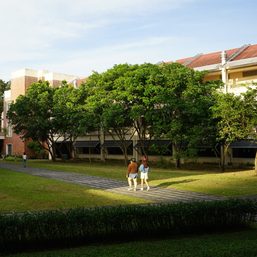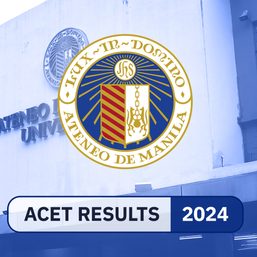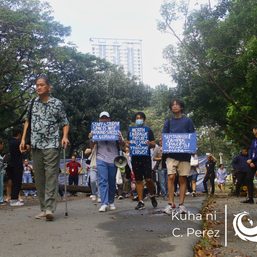SUMMARY
This is AI generated summarization, which may have errors. For context, always refer to the full article.
![[OPINION] The Katipunan litmus test](https://www.rappler.com/tachyon/2024/01/admu-tree-cutting.jpg)
In a 1950 public lecture, Martin Heidegger spoke of nearness as remaining ever so elusive despite all our efforts that are aided by modern science and technology. “The frantic abolition of all distances,” writes the German philosopher, “brings no nearness; for nearness does not consist in shortness of distance…. What is nearness if it fails to come about despite the reduction of the longest distances to the shortest intervals? What is nearness if it is even repelled by the restless abolition of distances?”
Such frantic and restless abolition of distances not only costs enormous amounts of money and energy. Worse, the places we used to go to now even seem to have become farther away and can be reached only in exchange for being forced to undergo a very stressful experience.
A few months ago, as I was walking back to the Ateneo de Manila University campus at noontime, I saw my colleague Angelli going in the same direction. As we entered the campus we looked all around us, cars upon cars upon cars standing still, completely motionless, stuck in traffic, right inside the campus, so terrible that many would now describe it as hellish.
Once the cars could somehow manage to get out of campus, the ordeal would by no means be over, for in Dante’s Inferno there could well be fewer circles of hell.
As we crossed the road on a pedestrian lane, which is now perhaps twice, thrice, or four times longer because the vehicular entrance and exit points had been widened to accommodate more and more cars, Angelli quipped with an unmistakeable tone of resignation, “They simply moved the bottleneck to another location.”
Such has been the daily situation in Katipunan area for many years now, and each year it only gets worse. What little we gained during the pandemic (bicycle lanes, increased number of bike commuters) is no match against the continuing onslaught of vehicles.
Somehow the memory of this place more than 30 years ago, this place whose name has to do with gathering, with bringing near (ka-tipon-an), came back to my mind. As college students at the University of the Philippines in Diliman, my friends and I who lived in the dormitory would walk from the campus to the corner of Katipunan Road and Aurora Boulevard to have our favorite lugaw after long hours of studying at night.
Back then the whole stretch of Katipunan felt just like home, as the UP campus was home to all of us as well. There used to be an island on the southbound lane with huge trees that not only made it safer for us to walk along the road, protected from vehicles, but also made walking such a pleasure, and without us even having to spend a single centavo.
One day, 20 years later or so, those of us who lived within the Katipunan area would wake up to see the trees already uprooted, and the concrete island being demolished, to give way to more cars, and more cars, and more cars. Of course, they had to do it while people were asleep, like a thief in the night.
Katipunan is home to at least two of the country’s top universities and one of its oldest colleges, along with several opulent residential villages. In another world, one would expect many young people on both sides of the road walking or riding their bicycles. One would imagine a scene so vibrant and colorful and full of life, like the university towns we find elsewhere in the world.
There is no amount of campus or subdivision redesign (wider roads, road extensions, rerouting, more visible signs, etc.) that can put an end to our hellish nightmare, simply because we are all interconnected — our lives as well as our roads and streets and sidewalks.
The current controversy surrounding a car park renovation project at the Ateneo de Manila University must be seen within this larger context of interconnectedness.
Universities often wield considerable power and influence in society. And so, too, residential communities that have long made the place their home (especially if many of them are themselves in positions of power, whether in business or government). They must ask themselves whether they are merely reacting to the maddening addiction to cars (extending a road here, improving signage there, and so on), or whether they should finally come to their senses and begin the process of a radical change in the way we live our lives, in the way we dwell in the places we call home.
We can either face these hard but unavoidable questions or mindlessly go about our usual car-obsessed ways until we all choke and immobilize ourselves (ironically through automobiles) until the places we used to call home are no more.
By its sheer cultural, political, economic, and intellectual significance, there is no doubt that Katipunan is a litmus test of mobility, indeed of a way of life that is just, not only to ourselves as human beings, but to the very earth on which we all dwell.
Make no mistake about it: Fail this test, and we fail our future.
The choice is ours. – Rappler.com
Remmon E. Barbaza is an Associate Professor at the Department of Philosophy, Ateneo de Manila University.
Add a comment
How does this make you feel?
![[OPINION] Cutting trees in our Ateneo backyard](https://www.rappler.com/tachyon/2024/01/ateneo-trees-january-10-2024.jpg?fit=449%2C449)





There are no comments yet. Add your comment to start the conversation.